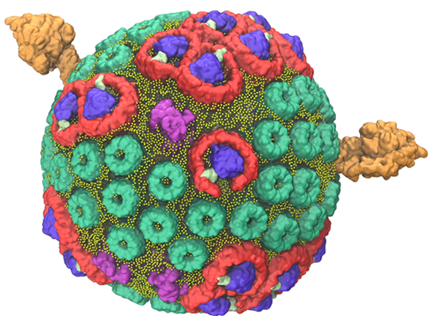Schulten to Deliver Keynote Lecture at Oberlin College
On September 10, 2015, Klaus Schulten is slated to deliver the keynote
address to inaugurate the college's new computer cluster as well as to
celebrate high-performance computing at the Ohio campus. The title of
the talk is
Towards an Atomic Level Description of a Whole Living Cell:
The Photosynthetic Chromatophore of Purple Bacteria, a Key Milestone
Abstract

The Photosynthetic Chromatophore, whose
atomic-level behavior has been resolved via
computational microscopy by TCBG.
Living systems, down to their smallest, truly living
components–cells–are made up of a huge number of molecules.
Resolving a cell molecule-by-molecule, namely at the level of chemistry
and physics, is a long-held dream, as this feat would link the life
sciences with the physical sciences at the most basic level. Can such a
highly resolving microscope ever be realized? The answer seems to be
yes, however, this microscope will take the form of a computer. Such
computational microscope is already being developed, programmed to build
on biological data, as well as on chemical and physical knowledge. When
can we expect to look through such a microscope and see a cell in all
its molecular detail? There is a good chance it will be around the year
2022, when the recently announced National Strategic Computing
Initiative is supposed to provide US researchers with the first ever
exascale computer. This computer will be a hundred times more powerful
than today's greatest US machine, Titan, located at Oak Ridge National
Laboratory. The optimism for soon resolving a whole cell with the
computational microscope derives from a breakthrough project already
achieved on Titan, namely, the molecule-by-molecule view of a so-called
cellular organelle, the photosynthetic chromatophore. This organelle is
about 100 nm in size and, in volume, is about a hundredth of a very
small living cell; exascale computing should enable accordingly the
study of a whole, yet small, cell. The view of the chromatophore through
the computational microscope, realized in full only this year, is
amazing and beautiful. One sees a clockwork of linked, mostly rather
elementary processes: light absorption producing optically excited
chlorophyll molecules; chlorophyll excitation spreading through the
entire chromatophore, inducing electron and proton transfer at certain
centers; electrons being moved around by different charge carriers;
protons being pumped into the chromatophores until the protons' pressure
becomes high enough that they mechanically drive synthesis of molecules
of ATP, a fuel that provides energy for most cellular activities. With
the computational microscopy of the chromatophore, a major part of a
biological cell has been resolved, for the first time in its entirety,
at the level of truly basic chemistry and physics, showcasing how
Angstrom-scale processes lead to 100-nm-scale overall function of solar
energy harnessed to make ATP. Reaching the same detailed view for an
entire living cell in 2022 promises an even better basic understanding
of life in general, and human health in particular.
Further Information
For more information about the TCBG work on the photosynthetic chromatophore,
see the following urls:




